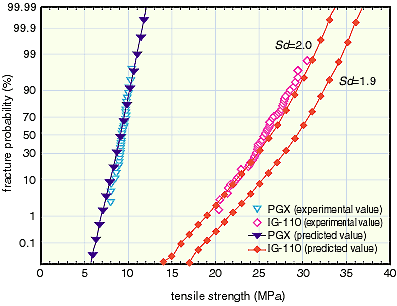| Recently, a model illustrating the fracture mechanism taking account
of microstructures of polycrystalline ceramics has been developed.
It successfully illustrates the tensile and bending strengths
of the ceramics. This is a probabilistic fracture strength model
taking into consideration the average grain size, pore number
density, average pore diameter, pore diameter distribution parameter,
fracture toughness of a grain, and specimen volume. The model
assumes that the material consists of a collective of cubic crystalline
particles of the same size. The calculation of fracture probability
is performed for the material in which slit-like cracks placed
uniformly and with random slopes to the stress axis grow in the
crystal grain. The six parameters described above are needed to
calculate the fracture probability. The first model was applicable
to the tensile strength and this model was extended to be applicable
to the bending strength. Figure 7-4 shows a comparison of experimental
values with the predicted ones when the model was applied to the
tensile strength of graphite. Both values for the coarse grained
graphite (PGX) coincide well. In the case of the fine grained
graphite (IG-110) both values coincide well if the pore size parameter
is taken to be large (Sd=2.0). This suggests that large size pores are dominant in the
fracture of the ceramics. When the model is applied to the bending
strength of silicon carbide, the result shown in the Fig. 7-5
is obtained. The experimental results indicate that the bending
fracture strengths of three kinds of silicon carbide (three different
grain sizes) can be well illustrated by the model. |

